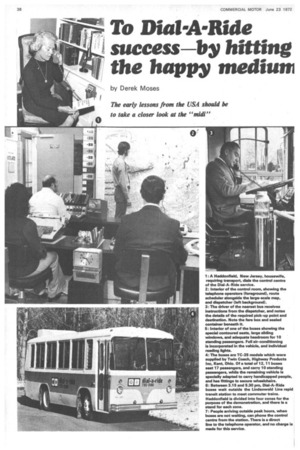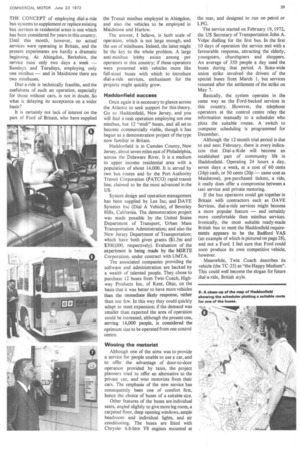To Dial-A-Ride success by hitting the happy medium
Page 38

Page 39

If you've noticed an error in this article please click here to report it so we can fix it.
by Derek Moses
THE CONCEPT of employing dial-a-ride bus systems to supplement or replace existing bus services in residential areas is one which has been considered for years in this country. Until this month, however, no actual services were operating in Britain, and the present experiments are hardly a dramatic beginning. At Abingdon, Berkshire, the service runs only two days a week — Sundays and Tuesdays, employing only one minibus — and in Maidstone there are two minibuses.
• Dial-a-ride is technically feasible, and the usefulness of such an operation, especially for those without cars, is not in doubt. So what is delaying its acceptance on a wider basis?
It is certainly not lack of interest on the part of Ford of Britain, who have supplied the Transit minibus employed in Abirrgdon, and also the vehicles to be employed in Maidstone and Harlow.
The answer, I believe, is both scale of operation, which is not large enough, and the use of minibuses. Indeed, the latter might be the key to the whole problem. A large anti-minibus lobby exists among psv operators in this country; if these operators were presented with vehicles more like full-sized buses with which to introduce dial-a-ride services, enthusiasm for the projects might quickly grow.
Haddonfield success Once again it is necessary to glance across the Atlantic to seek support for this theory.. Go to Haddonfield, New Jersey, and you will find a neat operation employing not one minibus, but 12 "midi" buses, and all set to become commercially viable, though it has begun as a demonstration project of the type now familiar in Britain.
Haddonfield is in Camden County, New Jersey, about seven miles east of Philadelphia, across the Delaware River. It is a medium to upper income residential area with a population of about 14,000. It is served by two bus routes and by the Port Authority Transit Corporation (PATCO) rapid transit line, claimed to be the most advanced in the US.
System design and operation management has been supplied by Lex Inc, and DAVE Systems Inc (Dial A Vehicle), of Beverley Hills, California. The demonstration project was made possible by the United States Department of Transport, Urban Mass Transportation Administration; and also the New Jersey Department of Transportation; which have both given grants (S1.5m and $300,000, respectively). Evaluation of the experiment is being made by the MIRTE Corporation, under contract with UMTA.
The associated companies providing the software and administration are backed by a wealth of talented people. They chose to purchase 12 buses from Twin Coach, Highway Products Inc, of Kent, Ohio, on the basis that it was better to have more vehicles than the immediate likely response, rather than too few. In this way they could quickly adapt to meet expansion; if the demand was smaller than expected the area of operation could be increased, although the present one, serving 14,000 people, is considered the optimum size to be operated from one control centre.
Wooing the motorist Although one of the aims was to provide a service for people unable to use a car, and to offer the advantage of door-to-door operation provided by taxis, the project planners tried to offer an alternative to the private car, and woo motorists from their cars. The emphasis of the new service has consequently been one of comfort first, hence the choice of buses of a suitable size.
Other features of the buses are individual seats, angled slightly to give more legroom, a carpeted floor, deep opening windows, ample headroom and individual lights, and air conditioning. The buses are fitted with Chrysler 6.8-litre V8 engines mounted at the rear, and designed to run on petrol or LPG.
The service started on February 19, 1972, the US Secretary of Transportation John A. Volpe dialling for the first bus. In the first 10 days of operation the service met with a favourable response, attracting the elderly, youngsters, churchgoers and shoppers. An average of 350 people a day used the buses during that period. A State-wide union strike involved the drivers of the special buses from March 1, but services resumed after the settlement of the strike on May 7.
Basically, the system operates in the same way as the Ford-backed services in this country. However, the telephone operators at the control centre relay the information manually to a scheduler who plots the suitable routes. A switch to computer scheduling is programmed for December.
Although the 12-month trial period is due to end next February, there is every indication that Dial-a-Ride will become an established part of community life in Haddonfield. Operating 24 hours a day, seven days a week, at a cost of 60 cents (24p) cash, or 50 cents (20p — same cost as Maidstone), pre-purchased tickets, a ride, it really does offer a compromise between a taxi service and private motoring.
If the bus operators could get together in Britain with contractors such as DAVE Services, dial-a-ride services might become a more popular feature — and certainly more comfortable than minibus services. Ironically, the most suitable ready-made British bus to meet the Haddonfield requirements appears to be the Bedford VAS (an example of which is pictured on page 28), and not a Ford. I feel sure that Ford could soon produce its own competitive vehicle, however.
Meanwhile, Twin Coach describes its vehicle (the TC-25) as "the Happy Medium". This could well become the slogan for future dial-a-ride, British style.












































































































